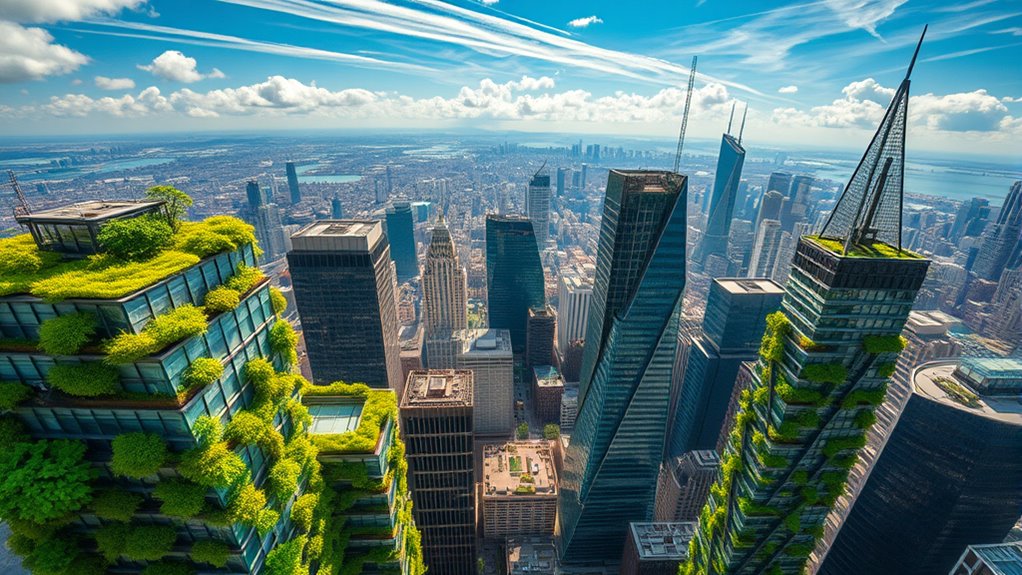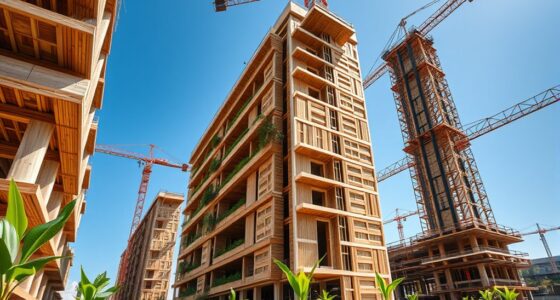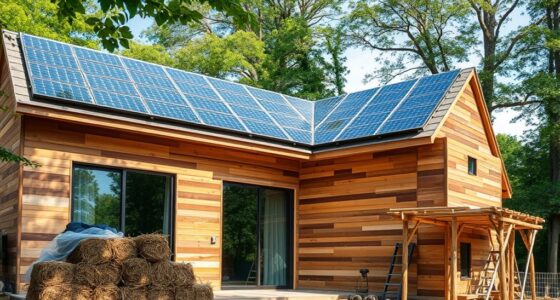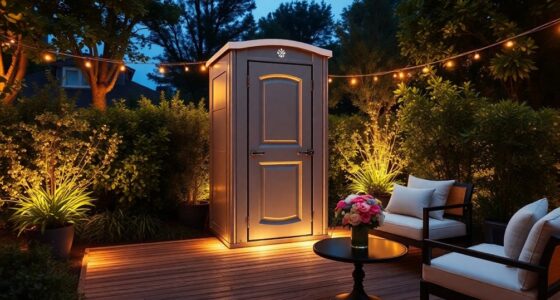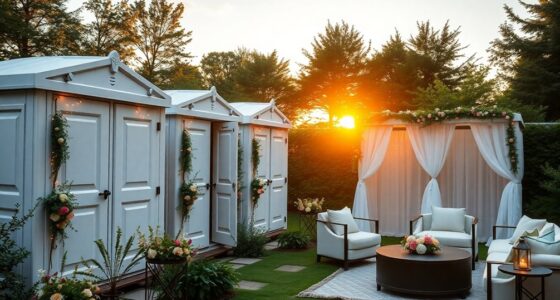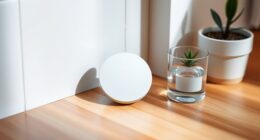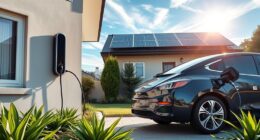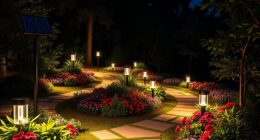Green roofs and living walls are transforming skyscrapers into eco-friendly landmarks by boosting urban biodiversity, improving energy efficiency, and mitigating the urban heat island effect. They help manage stormwater, reduce energy costs, and enhance air quality—making cities healthier and more resilient. These innovative green solutions showcase a commitment to sustainability and urban harmony. If you want to explore how this trend is shaping modern architecture, you’ll find plenty more fascinating details ahead.
Key Takeaways
- Green roofs and living walls enhance urban biodiversity and ecological balance in skyscraper-dense cities.
- They improve building energy efficiency by providing natural insulation and temperature regulation.
- These features help mitigate the urban heat island effect and boost climate resilience.
- Green roofs manage stormwater runoff, reducing flooding and strain on city drainage systems.
- They demonstrate sustainable design innovation, setting new standards for eco-friendly skyscraper architecture.
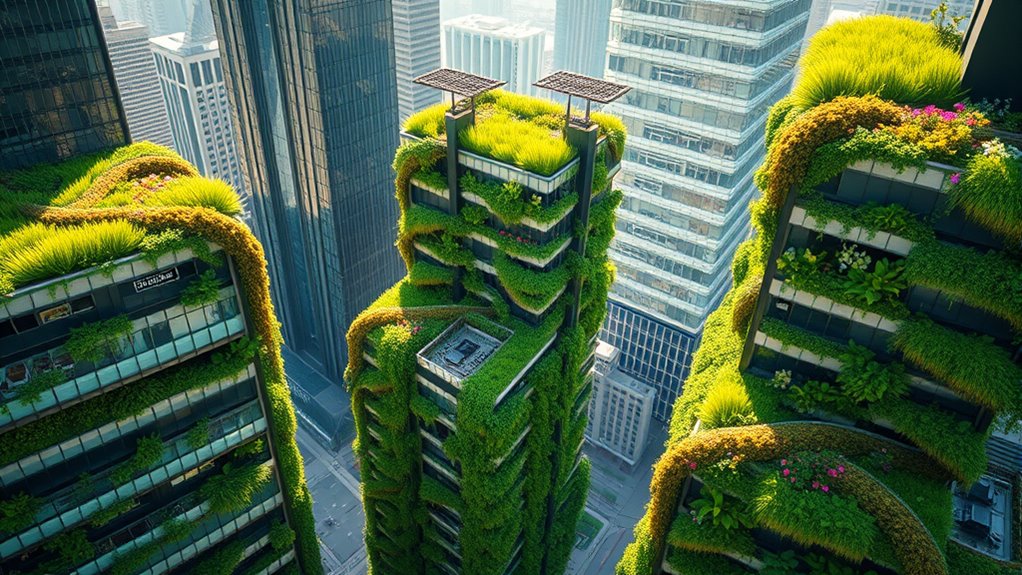
Green roofs and living walls are innovative ways to bring nature into urban environments, offering numerous environmental and economic benefits. When you incorporate these features into skyscrapers, you not only enhance their aesthetic appeal but also notably boost urban biodiversity. By creating habitats for birds, insects, and plants, you help restore some of the ecological balance lost in densely built areas. This increase in urban biodiversity can lead to healthier ecosystems within the city, encouraging pollinators and other beneficial species to thrive amidst the concrete jungle. Plus, these green installations serve as essential refuges in environments where natural green spaces are limited, making your building a part of a larger ecological network.
Beyond supporting biodiversity, green roofs and living walls improve energy efficiency in buildings. You’ll notice that they act as natural insulators, reducing the need for heating in winter and cooling during summer. The plants on these surfaces absorb sunlight, which helps regulate the temperature of the building’s exterior. This means less reliance on HVAC systems, leading to lower energy consumption and reduced utility bills. The added insulation also shields the building from temperature fluctuations, protecting it from extreme weather and decreasing the stress on heating and cooling equipment. Over time, these energy savings can be considerable, putting money back into your pocket while also reducing your carbon footprint.
Implementing green roofs and living walls isn’t just about aesthetics or energy savings; it’s a strategic move that addresses some of the most pressing urban challenges. As cities grow denser, the heat island effect intensifies, raising temperatures and straining infrastructure. Your green rooftop can mitigate this by providing a cooling effect, improving air quality, and reducing overall urban heat. This creates a more comfortable environment for everyone and makes your building a model of sustainable urban development. Additionally, green roofs can help manage stormwater runoff by absorbing rainwater, which reduces the burden on city drainage systems and minimizes flooding risks. Incorporating these features also supports urban resilience by making cities more adaptable to climate change impacts.
Incorporating these features also sends a strong message about your commitment to sustainability. It sets a precedent for other buildings and developers, showcasing how innovative design can harmonize urban living with nature. As you embrace green roofs and living walls, you’re contributing to a greener, more resilient city that prioritizes ecological health, energy conservation, and quality of life. It’s a forward-thinking choice that benefits the environment, your wallet, and the community, making it clear that sustainable urban architecture is the way of the future.
Frequently Asked Questions
How Long Do Green Roofs Typically Last?
Green roofs typically last 20 to 50 years, depending on factors like plant selection and structural integrity. You need to choose hardy, well-suited plants to reduce maintenance and guarantee longevity. Regular inspections help maintain the structural integrity of the roof, preventing issues that could shorten its lifespan. Proper installation and ongoing care are essential for maximizing the lifespan of your green roof, making it a sustainable, long-term addition to your building.
Are Green Walls Suitable for All Building Types?
You might wonder if green walls suit all building types. Generally, they enhance urban biodiversity and improve building insulation, making them beneficial for many structures. However, your building’s design, structural capacity, and location influence their suitability. You should assess whether the wall can support the weight and maintenance needs. With proper planning, green walls can thrive and provide ecological and energy benefits across diverse building types.
What Are the Maintenance Requirements for Living Walls?
Living walls require regular maintenance to stay healthy. You’ll need to monitor your irrigation systems to make certain plants get enough water without overwatering. Choosing the right plants is vital; select species suited to your climate and light conditions. You should also prune, replace dead plants, and check for pests periodically. Consistent care keeps your living wall vibrant, thriving, and visually appealing, making maintenance a manageable part of your building’s eco-friendly design.
Do Green Roofs Improve Urban Air Quality?
You might wonder if green roofs truly improve urban air quality. They do, by enhancing air purification through plants that filter pollutants and CO2. Additionally, they help reduce noise pollution, creating a calmer environment. Green roofs also lower temperatures, which can decrease smog formation. Overall, they contribute to healthier, cleaner cities, making urban spaces more livable for everyone.
What Are the Initial Costs of Installing Green Roofs?
The initial costs of installing green roofs can seem astronomical, but they’re a essential investment in your building’s future. Your initial investment covers structural support, waterproofing, and planting. Budget considerations vary based on the green roof type and size, but don’t let costs scare you. Think of it as planting a lush haven in your city—worth every penny for the environmental and aesthetic benefits it brings.
Conclusion
Imagine walking through a city where over 10 million square feet of green roofs and living walls thrive, transforming concrete jungles into lush, vibrant spaces. You might not notice it at first, but this trend reduces urban heat by up to 40%, cooling your environment and saving energy. By embracing green roofs and living walls, you’re part of a movement that not only beautifies your surroundings but also fights climate change—one building at a time.
